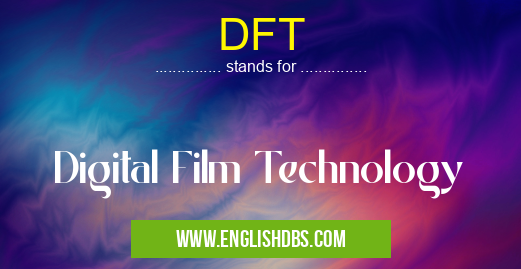What does DFT mean in TECHNOLOGY
Digital Film Technology (DFT) is a revolutionary advancement in filmmaking that employs digital tools and techniques to capture, process, and project motion pictures. It has significantly transformed the film industry, offering numerous advantages over traditional analog film-based methods.

DFT meaning in Technology in Computing
DFT mostly used in an acronym Technology in Category Computing that means Digital Film Technology
Shorthand: DFT,
Full Form: Digital Film Technology
For more information of "Digital Film Technology", see the section below.
» Computing » Technology
DFT's Impact on Filmmaking
- Enhanced Image Quality: DFT allows for higher resolution, sharper images with improved color accuracy and detail.
- Simplified Post-Production: Digital editing and effects software enable filmmakers to manipulate footage more easily and precisely than with analog film.
- Cost-Effective Production: DFT eliminates the need for expensive film stock and processing, reducing production costs.
- Greater Creative Freedom: Digital technology provides filmmakers with a wider range of creative possibilities, from advanced visual effects to non-linear storytelling techniques.
Essential Questions and Answers on Digital Film Technology in "COMPUTING»TECHNOLOGY"
What is Digital Film Technology (DFT)?
DFT is a digital capture and projection system for motion pictures. It uses electronic sensors instead of film to record and project images.
What are the advantages of DFT over traditional film technology?
DFT offers several advantages, including higher image quality, greater flexibility in post-production, and reduced costs compared to film.
How does DFT work?
DFT cameras use electronic sensors to capture light and convert it into digital signals. These signals are then stored on digital media for editing and projection. DFT projectors use digital light projectors to create images on a screen.
What is the difference between DFT and digital video?
DFT is specifically designed for motion pictures, while digital video is intended for television and other video applications. DFT systems typically use higher-resolution sensors and more advanced image processing techniques than digital video systems.
What is the future of DFT?
DFT is expected to continue to evolve, with advancements in sensor technology, image processing, and projection systems. It is likely to become increasingly common in filmmaking and exhibition.
Final Words: Digital Film Technology has become the industry standard for filmmaking, offering unparalleled image quality, simplified post-production, cost-effective production, and enhanced creative freedom. Its adoption has revolutionized the way movies are made and experienced, paving the way for innovative and captivating cinematic experiences.
DFT also stands for: |
|
| All stands for DFT |
